SpinENGINE
Harnessing the Emergent Properties of Nanomagnet Ensembles for Massively Parallel Data Analysis
About the SpinENGINE project
The SpinENGINE project will lay the foundations for a new, massively parallel, platform based on emergent behaviour in nanomagnet ensembles. The project will an efficient, highly scalable, and easily reproducible platform meeting the data challenges in our increasingly data-rich society. We will build upon our recent discoveries and use complex, nonlinear, and highly tunable interactions in such ensembles to realize a hardware platform for “Reservoir Computing”, a biologically-inspired computational approach. Our critical hypothesis is that the synergies between the inherent properties of nanomagnet ensembles and those required for reservoir computing will enable the efficient creation of a highly adaptive computational platform for the analysis of complex, dynamic data sets. This has the potential to greatly outperform current approaches using conventional CMOS hardware.
SpinENGINE will bring together a multidisciplinary team of researchers with expertise in computer science, condensed matter physics, material science, computational modelling, and high-resolution microscopy. This will enable us to simultaneously explore the fundamental behaviours of nanomagnet ensembles and understand how these can be harnessed for useful computation. By the end of the project, we aim to fabricate a proof-of-concept device capable of solving pattern recognition and classification problems, and, in collaboration with our industrial partner, IBM, produce a roadmap to the further scaling and commercialization of our computational platform. Success in the SpinENGINE project will have vast implications for data analysis at all scales, ranging from low power computation in the simplest sensor node to accelerated data processing in the most complex supercomputer.
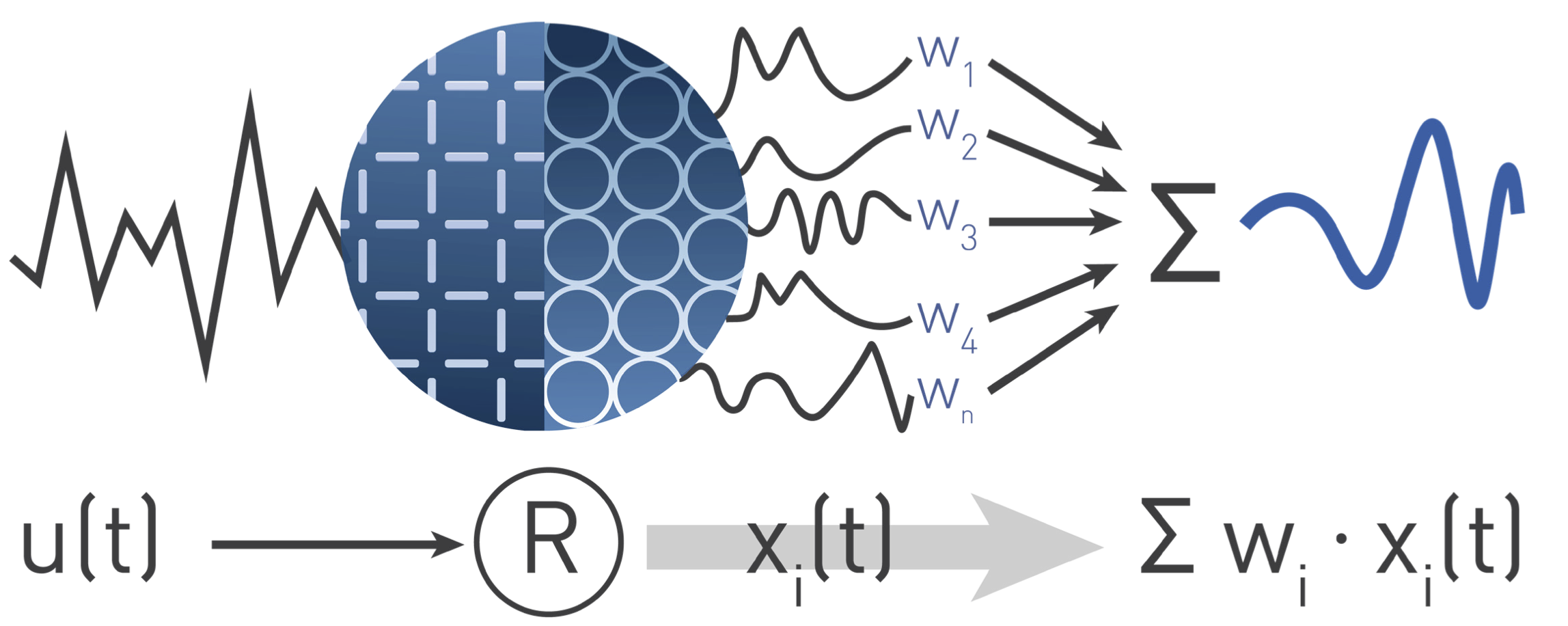
Publications
-
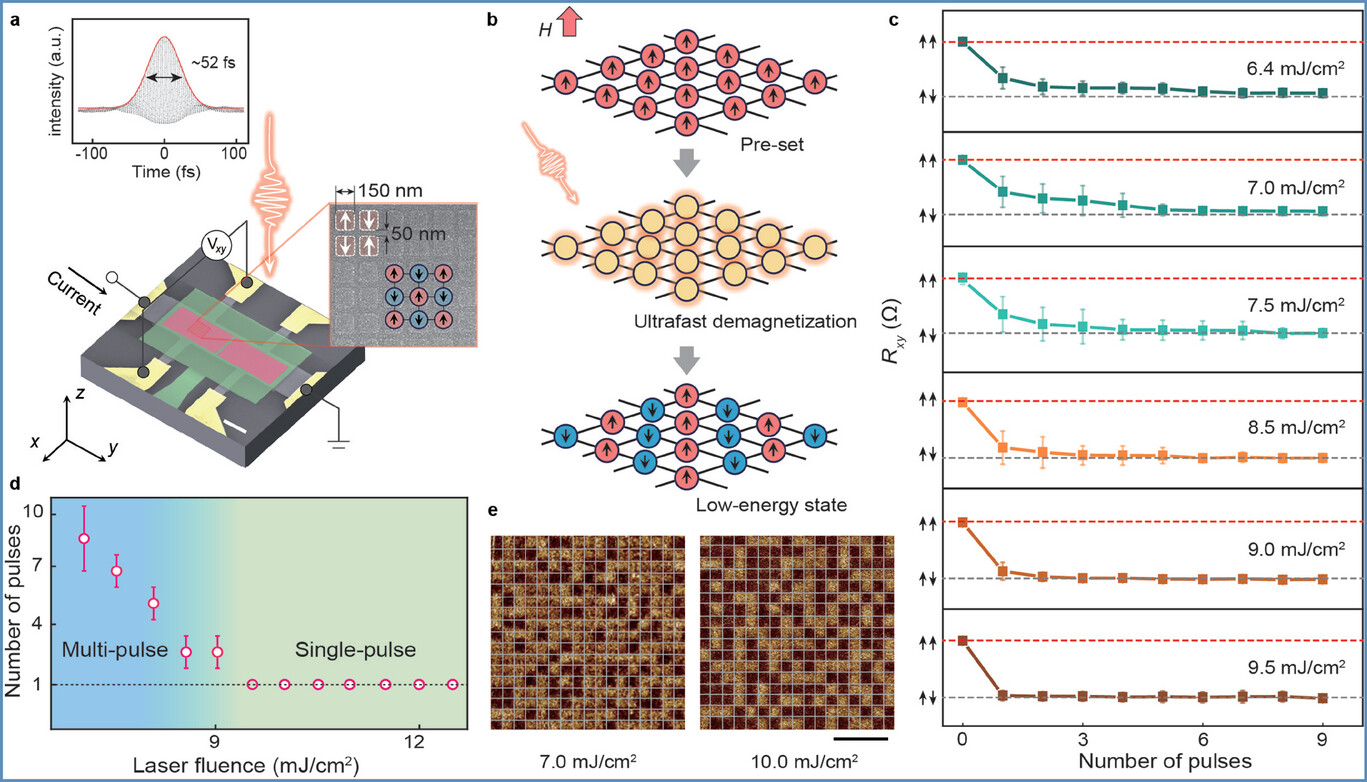 Ultrafast Probabilistic Neuron in an Artificial Spin Ice for Robust Deep Neural Networks
Ultrafast Probabilistic Neuron in an Artificial Spin Ice for Robust Deep Neural Networks
Z. Liang, T. Bu, Z. Lyu, Z. Liu, A. Hrabec, L. Wang, Y. Dou, J. Ding, P. Ge, W. Yang, T. Huang, J. Yang, L.J. Heyderman, Y. Liu, Z. Yu, Z. Luo Advanced Functional Materials, 2417334 13 December 2024 Open Access: https://doi.org/10.1002/adfm.202417334 Abstract: Deep neural networks (DNNs) have proved to be remarkably successful in various domains, in particular for implementing complex functions and performing sophisticated tasks. However, their vulnerability to adversarial noise undermines their reliability for safety-critical tasks. Despite attempts to improve the robustness using algorithmic approaches, an effective hardware implementation is still lacking. Here an artificial probabilistic neuron device is proposed based on arrays of coupled nanomagnets, referred to as artificial spin ices, which return a nonlinear function with built-in stochasticity in response to an ultrafast laser-induced excitation. By exploiting solid-state ionic gating, the magnetic coupling is electrically modulated, as a result of the magnetic anisotropy-mediated competition of the symmetric exchange interaction and Dzyaloshinskii-Moriya interaction, and hence the stochastic property of the neuron device at runtime can be tuned. Stochastic DNNs are then constructed with an output layer comprising several probabilistic neuron devices. Compared to conventional DNNs, the stochastic DNNs exhibit an order of magnitude greater resistance to adversarial noise, providing a significant improvement in robustness. This approach opens the way to more secure and reliable DNNs, enabling broader uses in real-world applications. -
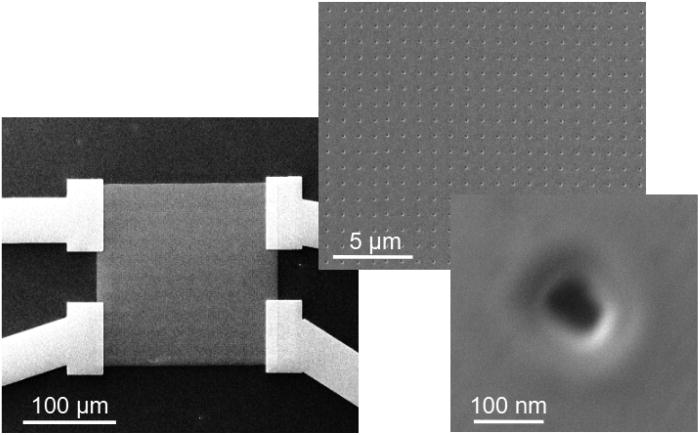 Antidot lattices for magnetic reservoir computing
Antidot lattices for magnetic reservoir computing
R. Allenspach, A. Bischof, R. Heller Applied Physics Letters 125, 222408, November 26 2024 DOI: https://doi.org/10.1063/5.0240085 Abstract: Reservoir computing can be implemented in a variety of systems beyond standard CMOS technology. Here, we describe a scheme that relies on a magnetic reservoir consisting of an antidot array, motivated by earlier experiments on ring arrays. We show that antidot lattices can be used as reservoirs much in the same way as ring arrays. We describe geometries in which smaller magnetic fields are needed to induce emergent magnetic patterns in the reservoir, a prerequisite for its use in reservoir computing. High-resolution magnetic imaging of these patterns shows entirely different domains and domain walls, despite the fact that the macroscopic magnetic signal behaves very similarly in both types of reservoirs. -
 Evolving Artificial Spin Ice for Robust Computation
Evolving Artificial Spin Ice for Robust Computation
Arthur George Penty and Gunnar Tufte International Journal of Unconventional Computing, 18, 4, 323-341 Open Access: https://hdl.handle.net/11250/3132921 Abstract: Artificial spin ice is a magnetic metamaterial showing particular promise as a novel substrate for unconventional computing. While simulations are invaluable for investigating new computational substrates, results must be robust to the noise and disorder of the physical world for device realisation. Here we investigate the computational robustness of artificial spin ice towards fabrication disorder. Using an evolutionary search, we explore different geometries of artificial spin ice for robust computation. We show that by neglecting to consider disorder in the search, we obtain geometries that suffer greatly when disorder is introduced. We then demonstrate that by explicitly including disorder as part of the evolutionary search process, we are able to discover novel geometries that are robust against disorder. We also find that these geometries perform well on new instances of disorder, and when they fail, we see signs of graceful degradation. -
 Evolving Music from a Self-Organising Nanomagnetic Orchestra
Evolving Music from a Self-Organising Nanomagnetic Orchestra
Arthur Penty and Gunnar Tufte Proceedings of the ALIFE 2023: Ghost in the Machine: Proceedings of the Artificial Life Conference. 2023 Open Access: https://doi.org/10.1162/isal_a_00667 Abstract: Artificial spin ice is a self-organising system of interacting nanomagnets which exhibits interesting and complex behaviour. In this paper we put the art in artificial spin ice, presenting a novel mapping from a dynamical state trajectory to MIDI music for an ensemble of instruments. An evolutionary algorithm is used to search for new artificial spin ice geometries of higher musical quality, making use of Zipfian and entropic measures. Geometries of high fitness were discovered, and music resulting from the best geometry found is presented alongside this paper. Aside from the primary outcome of producing novel music, this unique viewpoint of artificial spin ice could allow for a more intuitive observation of its dynamical properties, interpreting their state trajectories through the medium of music. -
 Clocked dynamics in artificial spin ice
Clocked dynamics in artificial spin ice
Johannes Høydahl Jensen, Anders Strømberg, Ida Breivik, Arthur George Penty, Miguel Angel Nino, Muhammad Waqas Khaliq, Michael Foerster, Gunnar Tufte, and Erik Folven Nature Communications 15, 964 (2024) Open Access: https://doi.org/10.1038/s41467-024-45319-7 Abstract: Artificial spin ice (ASI) are nanomagnetic metamaterials with a wide range of emergent properties. Through local interactions, the magnetization of the nanomagnets self-organize into extended magnetic domains. However, controlling when, where and how domains change has proven difficult, yet is crucial for technological applications. Here, we introduce astroid clocking, which offers significant control of ASI dynamics in both time and space. Astroid clocking unlocks a discrete, step-wise and gradual dynamical process within the metamaterial. Notably, our method employs global fields to selectively manipulate local features within the ASI. Sequences of these clock fields drive domain dynamics. We demonstrate, experimentally and in simulations, how astroid clocking of pinwheel ASI enables ferromagnetic domains to be gradually grown or reversed at will. Richer dynamics arise when the clock protocol allows both growth and reversal to occur simultaneously. With astroid clocking, complex spatio-temporal behaviors of magnetic metamaterials become easily controllable with high fidelity. -
 Lattice reservoirs: symmetry breaking and information flow in physical reservoir computing
Lattice reservoirs: symmetry breaking and information flow in physical reservoir computing
Thomas Aven, Johannes H. Jensen, and Gunnar Tufte Proceedings of the Artificial Life Conference, 2024 Open access: https://doi.org/10.1162/isal_a_00773 Abstract: Reservoir computing has become immensely popular for exploiting physical systems for computation. A multitude of physical reservoirs have been demonstrated, ranging from assembles of nanomagnets to living cultures of neurons. Unlike abstract software reservoirs, physical reservoirs are subject to spatial constraints which restricts the possible reservoir topologies. Here, we investigate lattice reservoirs, where nodes are placed on a regular lattice which defines the reservoir topology and its weights. Despite their simple regular structure, lattice reservoirs perform surprisingly well, in some cases outcompeting classical Echo State Networks. A key finding is the need for directed edges to facilitate information flow within the reservoir, highlighting the importance of symmetry breaking in physical reservoirs. We take advantage of the spatial nature of lattice reservoirs to discover key computational structures within, revealing what these reservoirs are actually doing. Lattice reservoirs bridge the gap between physics and computation, providing invaluable insight for the design and understanding of physical reservoirs. -
 On the Antiferromagnetic–Ferromagnetic Phase Transition in Pinwheel Artificial Spin Ice
On the Antiferromagnetic–Ferromagnetic Phase Transition in Pinwheel Artificial Spin Ice
Anders Strømberg, Einar Digernes, Rajesh Vilas Chopdekar, Jostein Grepstad, and Erik Folven arXiv: 2404.03973, April, 2024. Open Access: https://doi.org/10.48550/arXiv.2404.03973 Abstract: Nanopatterned magnetic thin films offer a platform for exploration of tailored magnetic properties such as emergent long-range order. A prominent example is artificial spin ice (ASI), where an arrangement of nanoscale magnetic elements, acting as macrospins, interact via their dipolar fields. In this study, we discuss the transition from antiferromagnetic (AF) to ferromagnetic (FM) long-range order in a square lattice ASI, as the magnetic elements are gradually rotated through 45° to a "pinwheel" configuration. The AF–FM transition is observed experimentally using synchrotron radiation x-ray spectromicroscopy and occurs for a critical rotation angle of the nanomagnets, contingent upon the dipolar coupling determined by their separation in the lattice. Large-scale magnetic dipole simulations show that the point-dipole approximation fails to capture the correct AF–FM transition angle. However, excellent agreement with experimental data is obtained using a dumbbell-dipole model which better reflects the actual dipolar fields of the magnets. This model explains the coupling-dependence of the transition angle, another feature not captured by the pointdipole model. Our findings resolve a discrepancy between measurement and theory in previous work on "pinwheel" ASIs. Control of the AF–FM transition and this revised model open for improved design of magnetic order in nanostructured systems. -
 The design, verification, and applications of Hotspice: a Monte Carlo simulator for artificial spin ice
The design, verification, and applications of Hotspice: a Monte Carlo simulator for artificial spin ice
Jonathan Maes, Diego De Gusem, Ian Lateur, Jonathan Leliaert, Aleksandr Kurenkov, and Bartel Van Waeyenberge arXiv: 2409.05580, September, 2024. Open Access: https://doi.org/10.48550/arXiv.2409.05580 Abstract: We present Hotspice, a Monte Carlo simulation software designed to capture the dynamics and equilibrium states of Artificial Spin Ice (ASI) systems with both in-plane (IP) and out-of-plane (OOP) geometries. An Ising-like model is used where each nanomagnet is represented as a macrospin, with switching events driven by thermal fluctuations, magnetostatic interactions, and external fields. To improve simulation accuracy, we explore the impact of several corrections to this model, concerning for example the calculation of the dipole interaction in IP and OOP ASI, as well as the impact of allowing asymmetric rather than symmetric energy barriers between stable states. We validate these enhancements by comparing simulation results with experimental data for pinwheel and kagome ASI lattices, demonstrating how these corrections enable a more accurate simulation of the behavior of these systems. We finish with a demonstration of 'clocking' in pinwheel and OOP square ASI as an example of reservoir computing. -
 Perpendicular-anisotropy artificial spin ice with spontaneous ordering: a platform for neuromorphic computing with flexible timescales
Perpendicular-anisotropy artificial spin ice with spontaneous ordering: a platform for neuromorphic computing with flexible timescales
Aleksandr Kurenkov, Jonathan Maes, Aleksandra Pac, Gavin Martin Macauley, Bartel Van Waeyenberge, Aleš Hrabec, and Laura Jane Heyderman arXiv: 2408.12182, August 2024. Open Access: https://doi.org/10.48550/arXiv.2408.12182 Abstract: Arrays of coupled nanomagnets have wide-ranging fundamental and practical applications in artificial spin ices, neuromorphic computing and spintronics. However, lacking in these fields are nanomagnets with perpendicular magnetic anisotropy with sufficient magnetostatic interaction. This would not only open up new possibilities for artificial spin ice geometries but also enable novel coupling methods for applications. Here we demonstrate a method to engineer the energy landscape of artificial spin lattices with perpendicular magnetic anisotropy. With this, we are able to realize for the first time magnetostatically-coupled 2D lattices of out-of-plane Ising spins that spontaneously order at room temperature on timescales that can be precisely engineered. We show how this property, together with straightforward electrical interfacing, make this system a promising platform for reservoir computing. Our results open the way to investigate the thermodynamics of out-of-plane magnetostatically coupled nanomagnet arrays with novel spin ice geometries, as well as to exploit such nanomagnet arrays in unconventional computing, taking advantage of the adjustable temporal dynamics and strong coupling between nanomagnets. -
 Dzyaloshinskii-Moriya interaction in Ni/Cu(001)
Dzyaloshinskii-Moriya interaction in Ni/Cu(001)
R. Allenspach, A. Bischof, B. Boehm, U. Drechsler, O. Reich, M. Sousa, S. Tacchi, and G. Carlotti
Physical Review B, 110, 014402, July 2024
Open Access: https://doi.org/10.1103/PhysRevB.110.014402
Abstract: Dzyaloshinskii-Moriya interaction (DMI) is found in the epitaxial Ni/Cu(001) system by imaging magnetic domain wall profiles with high resolution and by Brillouin light scattering. The domain walls have right-handed chirality and deviate from both the Néel and Bloch configurations for Ni thicknesses up to 9 nm. From a detailed structural analysis it is found that strain in the Ni film is inhomogeneous with film thickness. We suggest that this strain field is responsible for the symmetry breaking that is required for a sizable DMI to appear, even in absence of a heavy metal. -
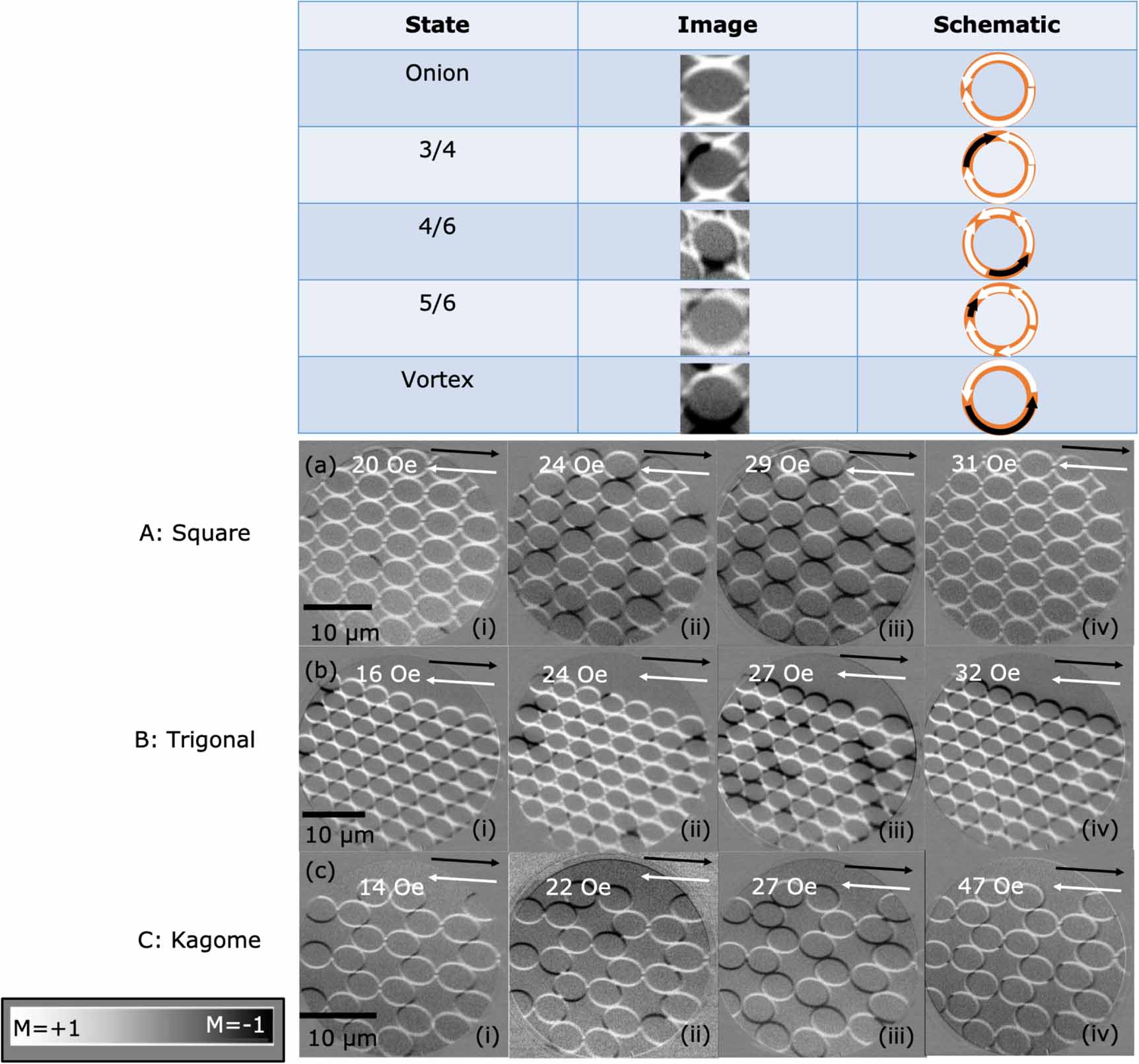 Exploring physical and digital architectures in magnetic nanoring array reservoir computers
Exploring physical and digital architectures in magnetic nanoring array reservoir computers
Guru Venkat, I T Vidamour, C Swindells, P W Fry, M C Rosamond, M Foerster, M A Niño, D Griffin, S Stepney, Dan A Allwood, and Thomas James Hayward
Neuromorphic Computing and Engineering, June 2024
Open Access: https://doi.org/10.1088/2634-4386/ad53f9
Abstract: Physical reservoir computing (RC) is a machine learning technique that is ideal for processing of time dependent data series. It is also uniquely well-aligned to in materio computing realisations that allow the inherent memory and non-linear responses of functional materials to be directly exploited for computation. We have previously shown that square arrays of interconnected magnetic nanorings are attractive candidates for in materio RC, and experimentally demonstrated their strong performance in a range of benchmark tasks (Dawidek et al 2021 Adv. Funct. Mater.31 2008389, Vidamour et al 2022 Nanotechnology33 485203, Vidamour et al 2023 Commun. Phys.6 230). Here, we extend these studies to other lattice arrangements of rings, including trigonal and Kagome grids, to explore how these affect both the magnetic behaviours of the arrays, and their computational properties. We show that while lattice geometry substantially affects the microstate behaviour of the arrays, these differences manifest less profoundly when averaging magnetic behaviour across the arrays. Consequently the computational properties (as measured using task agnostic metrics) of devices with a single electrical readout are found to be only subtly different, with the approach used to time-multiplex data into and out of the arrays having a stronger effect on properties than the lattice geometry. However, we also find that hybrid reservoirs that combine the outputs from arrays with different lattice geometries show enhanced computational properties compared to any single array. -
 Enhancement of spin Seebeck effect in Fe3O4/Pt thin films with α-Fe nanodroplets
Enhancement of spin Seebeck effect in Fe3O4/Pt thin films with α-Fe nanodroplets
Guru Venkat, Christopher D. W. Cox, Zhaoxia Zhou, Naëmi Leo, Christy J. Kinane, Andrew J. Caruana, and Kelly Morrison
Applied Physics Letters, 123 (17): 172408, October 2023
Open Access: https://doi.org/10.1063/5.0165851
Abstract: In this study, we demonstrate an enhancement of the measured spin Seebeck coefficient in Fe3O4/Pt bilayer films due to an increase in Fe nanodroplets formed by pulsed laser deposition. Four bilayer films were deposited at the same time from a highly textured target, resulting in a general increase in droplet formation that was confirmed to be Fe rich by scanning electron microscope and transmission electron microscope-dispersive x-ray spectroscopy. Of these four films, there were two distinct groupings with differing density of α-Fe droplets, where the bilayer with higher droplet density exhibited a 64% increase in the measured spin Seebeck coefficient from 38 to 63 nV m/W. -
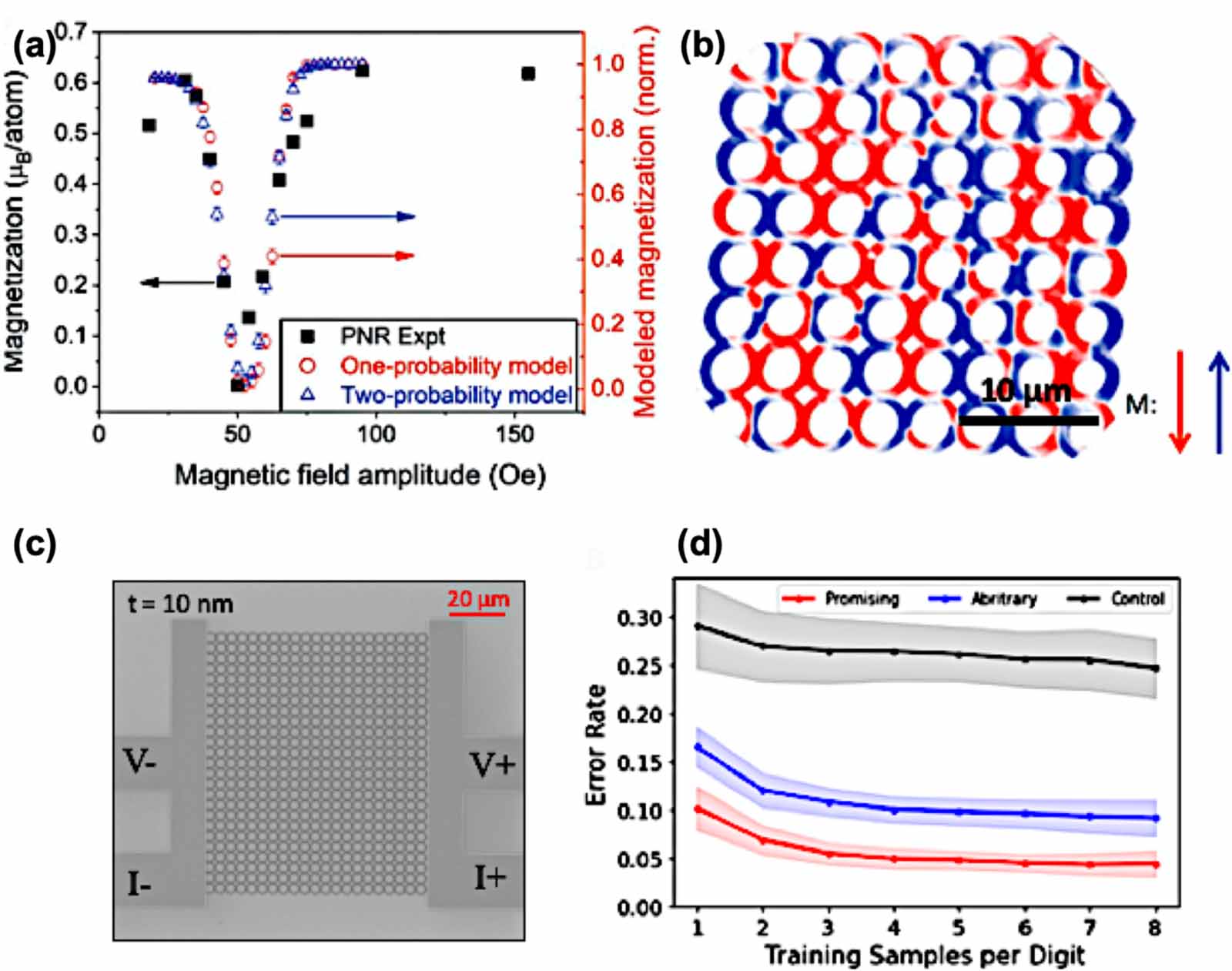 Magnetic domain walls: types, processes and applications
Magnetic domain walls: types, processes and applications
Guru Venkat, Dan A Allwood, and Thomas James Hayward
Journal of Physics D: Applied Physics, October 2023
Open Access: https://doi.org/10.1088/1361-6463/ad0568
Abstract: Domain walls (DWs) in magnetic nanowires are promising candidates for a variety of applications including Boolean/unconventional logic, memories, in-memory computing as well as magnetic sensors and biomagnetic implementations. They show rich physical behaviour and are controllable using a number of methods including magnetic fields, charge and spin currents and spin-orbit torques. In this review, we detail types of domain walls in ferromagnetic nanowires and describe processes of manipulating their state. We look at the state of the art of DW applications and give our take on the their current status, technological feasibility and challenges. -
 Electrically programmable magnetic coupling in an Ising network exploiting solid-state ionic gating
Electrically programmable magnetic coupling in an Ising network exploiting solid-state ionic gating
Chao Yun, Zhongyu Liang, Aleš Hrabec, Zhentao Liu, Mantao Huang, Leran Wang, Yifei Xiao, Yikun Fang, Wei Li, Wenyun Yang, Yanglong Hou, Jinbo Yang, Laura J. Heyderman, Pietro Gambardella, and Zhaochu Luo
Nature Communications, volume 14, Article number: 6367, October 2023
Open Access: https://doi.org/10.1038/s41467-023-41830-5
Abstract: Two-dimensional arrays of magnetically coupled nanomagnets provide a mesoscopic platform for exploring collective phenomena as well as realizing a broad range of spintronic devices. In particular, the magnetic coupling plays a critical role in determining the nature of the cooperative behavior and providing new functionalities in nanomagnet-based devices. Here, we create coupled Ising-like nanomagnets in which the coupling between adjacent nanomagnetic regions can be reversibly converted between parallel and antiparallel through solid-state ionic gating. This is achieved with the voltage-control of the magnetic anisotropy in a nanosized region where the symmetric exchange interaction favors parallel alignment and the antisymmetric exchange interaction, namely the Dzyaloshinskii-Moriya interaction, favors antiparallel alignment of the nanomagnet magnetizations. Applying this concept to a two-dimensional lattice, we demonstrate a voltage-controlled phase transition in artificial spin ices. Furthermore, we achieve an addressable control of the individual couplings and realize an electrically programmable Ising network, which opens up new avenues to design nanomagnet-based logic devices and neuromorphic computers. -
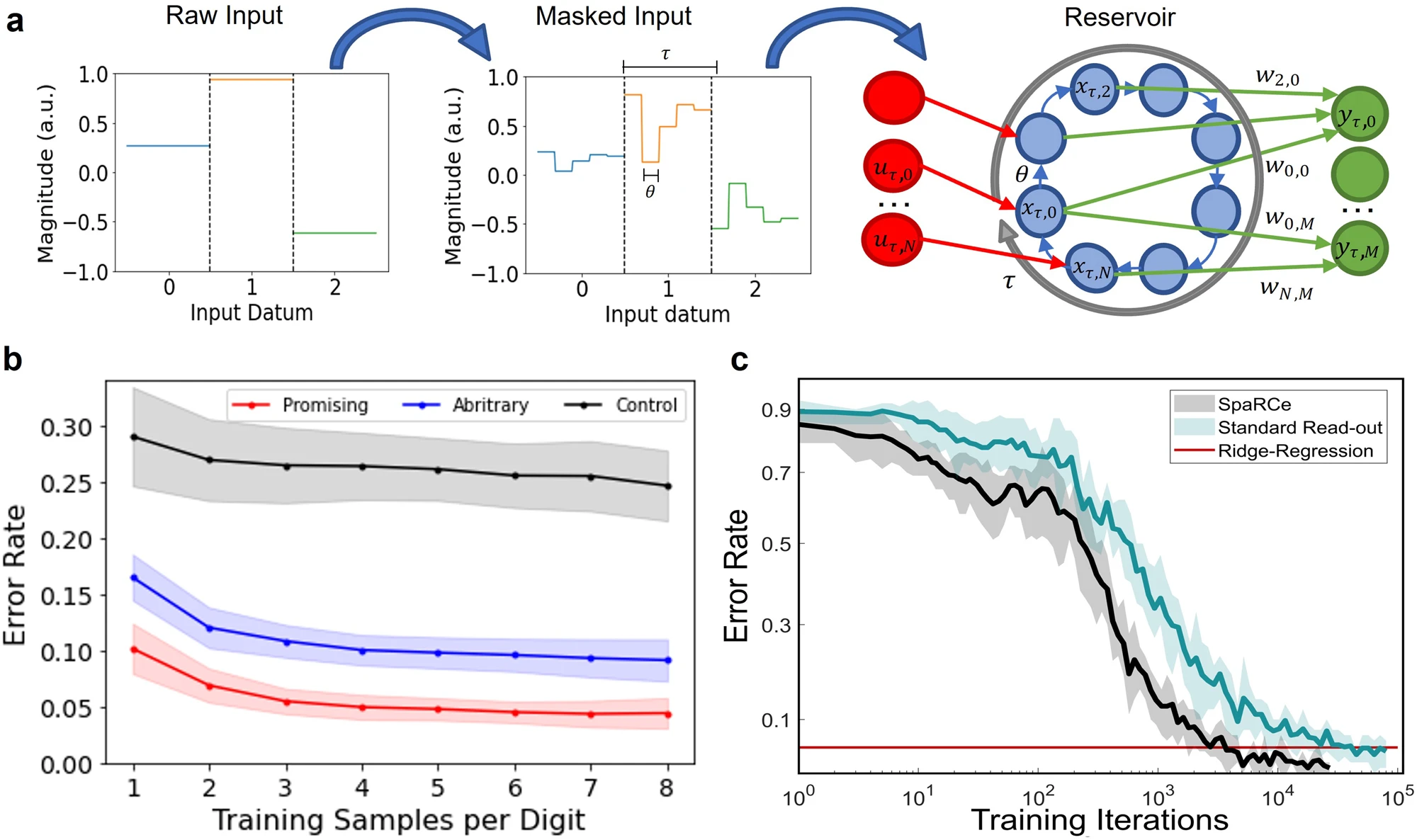 Reconfigurable reservoir computing in a magnetic metamaterial
Reconfigurable reservoir computing in a magnetic metamaterial
I.T. Vidamour, C. Swindells, G. Venkat, L. Manneschi, P. W. Fry, A. Welbourne, R. M. Rowan-Robinson, D. Backes, F. Maccherozzi, S. S. Dhesi, E. Vasilaki, D. A. Allwood, and T. J. Hayward
Communications Physics, volume 6, Article number: 230, August 2023
Open Access: https://doi.org/10.1038/s42005-023-01352-4
Abstract: In-materia reservoir computing (RC) leverages the intrinsic physical responses of functional materials to perform complex computational tasks. Magnetic metamaterials are exciting candidates for RC due to their huge state space, nonlinear emergent dynamics, and non-volatile memory. However, to be suitable for a broad range of tasks, the material system is required to exhibit a broad range of properties, and isolating these behaviours experimentally can often prove difficult. By using an electrically accessible device consisting of an array of interconnected magnetic nanorings- a system shown to exhibit complex emergent dynamics- here we show how reconfiguring the reservoir architecture allows exploitation of different aspects the system’s dynamical behaviours. This is evidenced through state-of-the-art performance in diverse benchmark tasks with very different computational requirements, highlighting the additional computational configurability that can be obtained by altering the input/output architecture around the material system. -
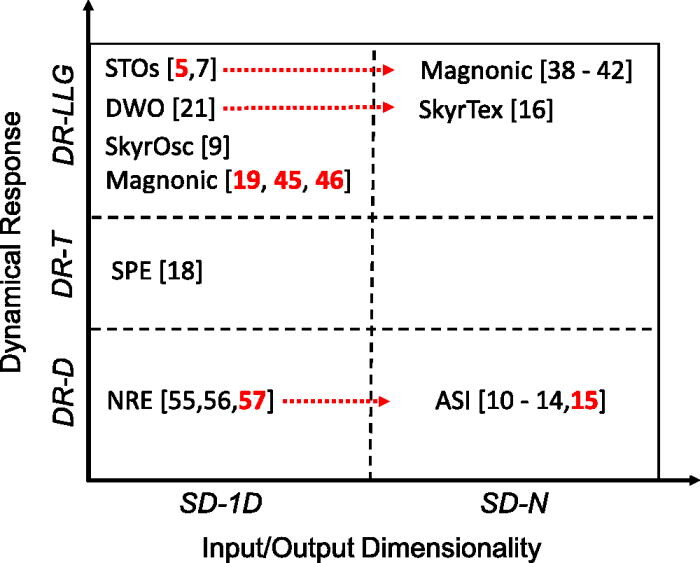 A perspective on physical reservoir computing with nanomagnetic devices
A perspective on physical reservoir computing with nanomagnetic devices
Dan A. Allwood, Matthew O. A. Ellis, David Griffin, Thomas J. Hayward, Luca Manneschi, Mohammad F. KH. Musameh, Simon O'Keefe, Susan Stepney, Charles Swindells, Martin A. Trefzer, Eleni Vasilaki, Guru Venkat, Ian Vidamour, and Chester Wringe
Appl. Phys. Lett. 122, 040501, January 2023
Open Access: https://journals.aps.org/prb/abstract/10.1103/PhysRevB.106.064408
Abstract: Neural networks have revolutionized the area of artificial intelligence and introduced transformative applications to almost every scientific field and industry. However, this success comes at a great price; the energy requirements for training advanced models are unsustainable. One promising way to address this pressing issue is by developing low-energy neuromorphic hardware that directly supports the algorithm's requirements. The intrinsic non-volatility, non-linearity, and memory of spintronic devices make them appealing candidates for neuromorphic devices. Here, we focus on the reservoir computing paradigm, a recurrent network with a simple training algorithm suitable for computation with spintronic devices since they can provide the properties of non-linearity and memory. We review technologies and methods for developing neuromorphic spintronic devices and conclude with critical open issues to address before such devices become widely used. -
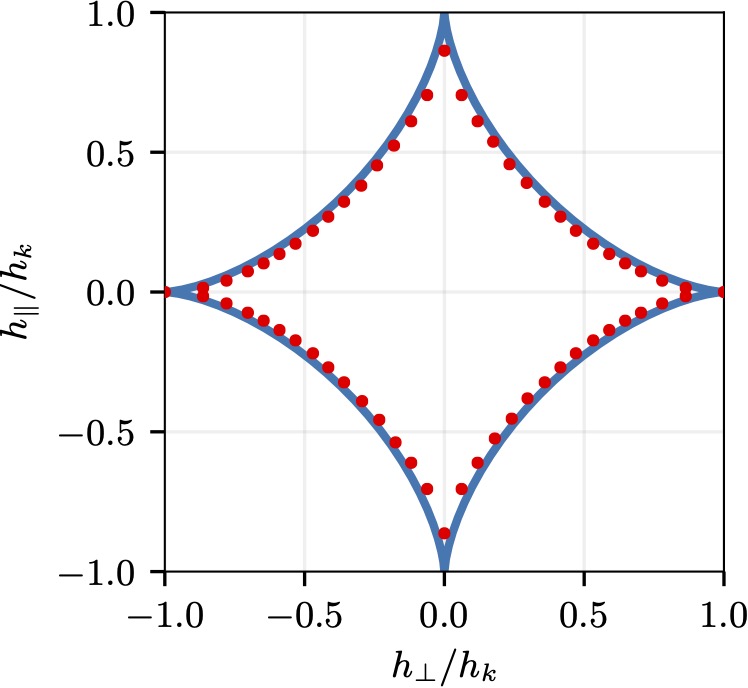 flatspin: A Large-Scale Artificial Spin Ice Simulator
flatspin: A Large-Scale Artificial Spin Ice Simulator
Johannes H. Jensen, Anders Strømberg, Odd Rune Lykkebø, Arthur Penty, Jonathan Leliaert, Magnus Själander, Erik Folven, and Gunnar Tufte
Phys. Rev. B 106, 064408, August 2022
Open Access: https://journals.aps.org/prb/abstract/10.1103/PhysRevB.106.064408
Abstract: We present flatspin, a novel simulator for systems of interacting mesoscopic spins on a lattice, also known as artificial spin ice (ASI). A generalization of the Stoner-Wohlfarth model is introduced, and combined with a well-defined switching protocol to capture realistic ASI dynamics using a point-dipole approximation. Temperature is modelled as an effective thermal field, based on the Arrhenius-Néel equation. Through GPU acceleration, flatspin can simulate the dynamics of millions of magnets within practical time frames, enabling exploration of large-scale emergent phenomena at unprecedented speeds. We demonstrate flatspin's versatility through the reproduction of a diverse set of established experimental results from literature. In particular, the field-driven magnetization reversal of “pinwheel” ASI is reproduced, for the first time, in a dipole model. Finally, we use flatspin to explore aspects of “square” ASI by introducing dilution defects and measuring the effect on the vertex population. -
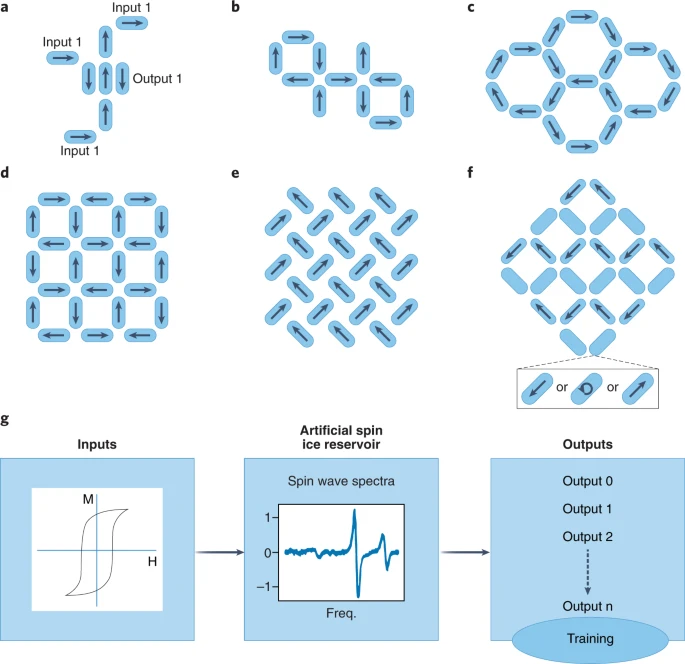 Spin ice devices from nanomagnets
Spin ice devices from nanomagnets
Laura J. Heyderman
Nat. Nanotechnol. 17, 435–436, May 2022
DOI: https://doi.org/10.1038/s41565-022-01088-2
Open Access: https://www.dora.lib4ri.ch/psi/islandora/object/psi%3A42800
Abstract: An artificial spin ice, containing two types of nanomagnets, can perform reservoir computing with minor magnetic field loops and spin wave spectra acting as inputs and outputs, respectively. In 2006, the term ‘artificial spin ice’ was coined to describe an array of magnetically coupled single-domain nanomagnets arranged on a square lattice. The array mimicked the behaviour of frustrated spins in the rare-earth titanate pyrochlores1. In the same year a well-designed arrangement of coupled nanoscale magnets performed logic operations for Boolean computation. This nanomagnetic logic, based on the minimisation of the stray field energy, caught the interest of researchers because of the promise of low power, high speed computing with non-volatile nanomagnets that could be downscaled. Subsequent work focused on the optimisation of nanomagnetic logic for the implementation in devices. In the field of artificial spin ice, scientists predominantly explored the fascinating physics that result from various geometries including emergent magnetic monopoles, phase transitions and magnetization dynamics. -
 Quantifying the Computational Capability of a
Nanomagnetic Reservoir Computing Platform with
Emergent Magnetisation Dynamics
Quantifying the Computational Capability of a
Nanomagnetic Reservoir Computing Platform with
Emergent Magnetisation Dynamics
Ian Vidamour, Matthew O.A. Ellis, David Griffin, Guru Venkat, Charles Swindells, Richard W. S. Dawidek, Thomas J Broomhall, Nina-Juliane Steinke, Joshaniel Cooper, Francesco Maccherozzi, Sarnjeet Dhesi, Susan Stepney, Eleni Vasilaki, Dan A Allwood and Tom James Hayward
Nanotechnology, August 2022
Open Access: https://doi.org/10.1088/1361-6528/ac87b5
Abstract: Devices based on arrays of interconnected magnetic nano-rings with emergent magnetization dynamics have recently been proposed for use in reservoir computing applications, but for them to be computationally useful it must be possible to optimise their dynamical responses. Here, we use a phenomenological model to demonstrate that such reservoirs can be optimised for classification tasks by tuning hyperparameters that control the scaling and input-rate of data into the system using rotating magnetic fields. We use task-independent metrics to assess the rings' computational capabilities at each set of these hyperparameters and show how these metrics correlate directly to performance in spoken and written digit recognition tasks. We then show that these metrics, and performance in tasks, can be further improved by expanding the reservoir's output to include multiple, concurrent measures of the ring arrays' magnetic states. -
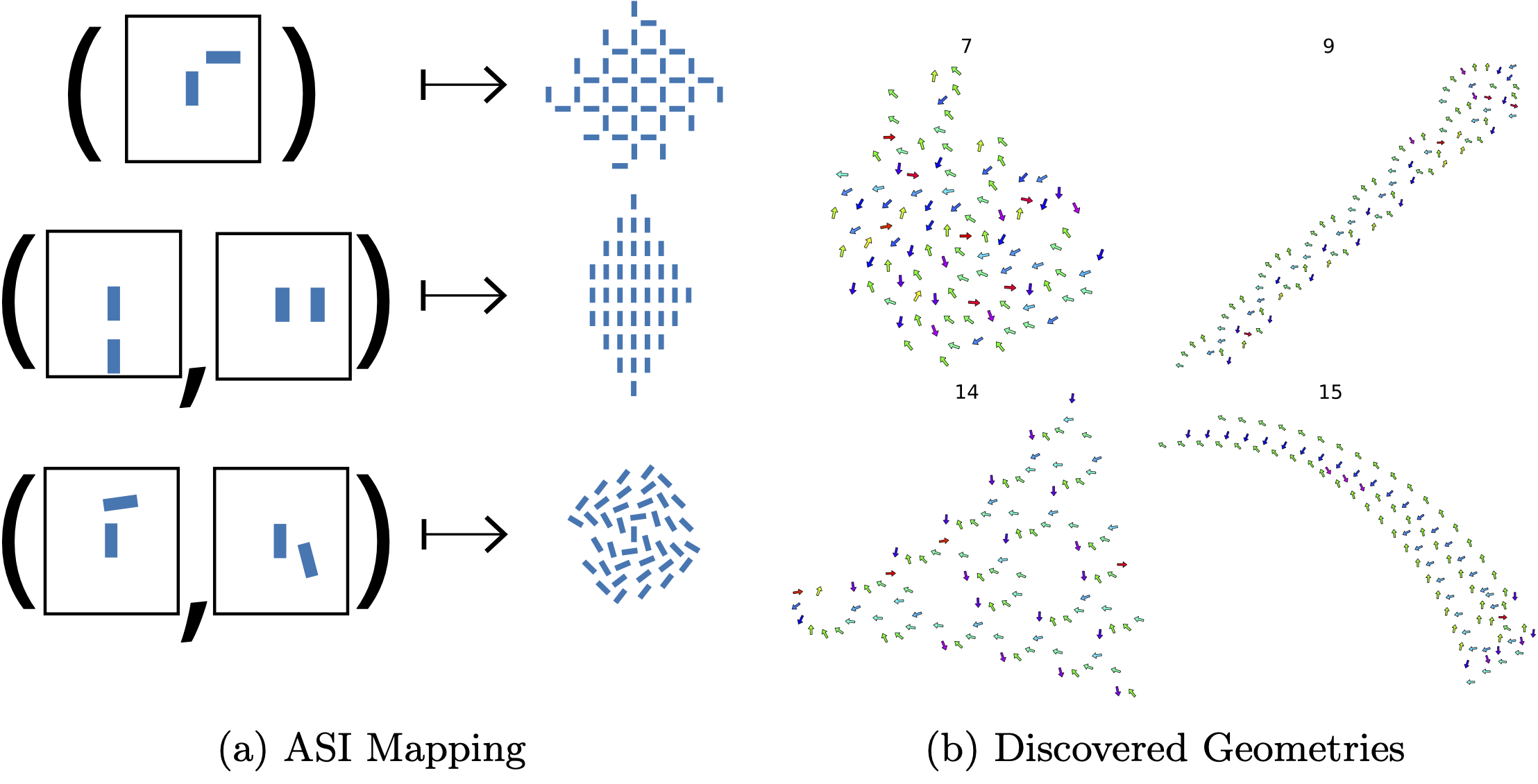 Sculpting the Spin Ice for Computation
Sculpting the Spin Ice for Computation
Arthur Penty and Gunnar Tufte
Proceedings of the International Conference on Unconventional Computation and Natural Computation, October 2021
Open Access: https://www.cs.york.ac.uk/nature/temc/TEMC2021-UCNC21/programme.pdf
Abstract: Ensembles of interacting nanomagnets known as Artificial Spin Ice (ASI) have become a promising new substrate for computation. Properties such as emergence and non-linear local interactions make it of particular interest for unconventional and material computation. Previously, we have proposed a method to represent and grow new ASI geometries, suited for use in an Evolutionary Algorithm (EA). Here we use our representation and evolution to further investigate towards computational properties including memory and classification. The richness of geometries found with sought computational properties indicates that ASI geometry is a fruitful tuning parameter for computational ASI systems. -
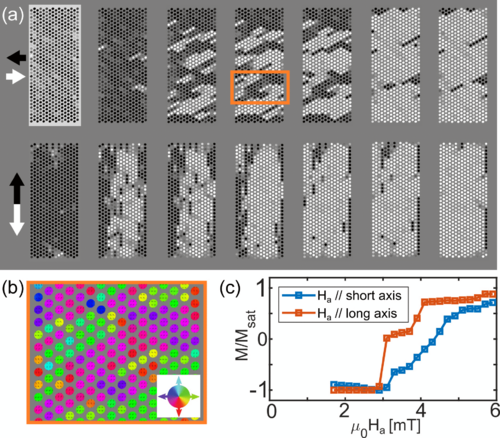 Effects of array shape and disk ellipticity in dipolar-coupled magnetic metamaterials
Effects of array shape and disk ellipticity in dipolar-coupled magnetic metamaterials
Sam D. Slöetjes, Einar S. Digernes, Anders Strømberg, Fredrik K. Olsen, Ambjørn D. Bang, Alpha T. N’Diaye, Rajesh V. Chopdekar, Erik Folven, and Jostein K. Grepstad
Physics Review B Vol.104, No. 134421, October 2021
Open Access: https://doi.org/10.1103/PhysRevB.104.134421
Abstract: Two-dimensional lattices of dipolar-coupled thin film ferromagnetic nanodisks give rise to emergent superferromagnetic (SFM) order when the spacing between dots becomes sufficiently small. In this paper, we define micron-sized arrays of permalloy nanodisks arranged on a hexagonal lattice. The arrays were shaped as hexagons, squares, and rectangles to investigate finite-size effects in the SFM domain structure for such arrays. The resulting domain patterns were examined using x-ray magnetic circular dichroism photoemission electron microscopy. At room temperature, we find these SFM metamaterials to be below their blocking temperature. Distinct differences were found in the magnetic switching characteristics of horizontally and vertically oriented rectangular arrays. The results are corroborated by micromagnetic simulations. -
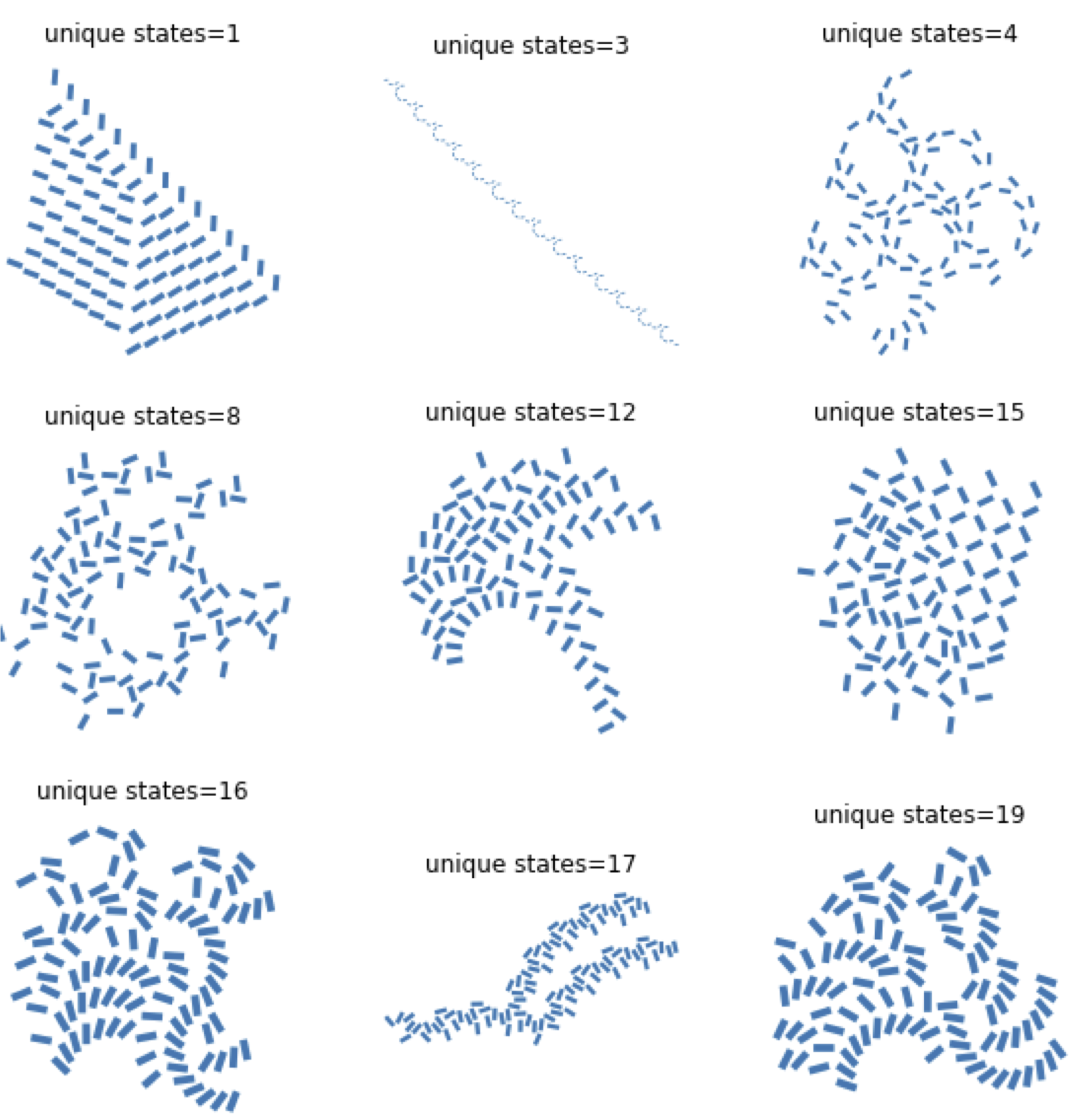 A Representation of Artificial Spin Ice for Evolutionary Search
A Representation of Artificial Spin Ice for Evolutionary Search
Arthur Penty and Gunnar Tufte
Proceedings of the Artificial Life Conference, July 2021
Open Access: https://direct.mit.edu/isal/proceedings/isal/99/102944
Abstract: Arrangements of nanomagnets known as artificial spin ices show great potential for use in unconventional computation. The majority of exploratory work done in this area considers just a small handful of well studied geometries (nanomagnetic arrangements), and uses them as if they were a black box. Here we detail a novel representation of artificial spin ice geometries, which lends itself to the tuning and evolutionary search of geometries. Using our representation we present geometries tuned to exhibit a desired computational or meta-material property. This is the first example of such a search performed on artificial spin ice. -
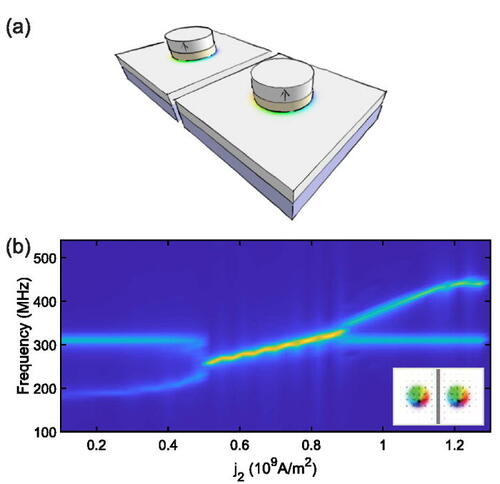 Synchronization of Chiral Vortex Nano-Oscillators
Synchronization of Chiral Vortex Nano-Oscillators
Zhiyang Zeng, Zhaochu Luo, Laura J. Heyderman, Joo-Von Kim, and Aleš Hrabec
Applied Physics Letters Vol. 118, No. 222405, June 2021
DOI: https://doi.org/10.1063/5.0048672 Open Access: https://www.dora.lib4ri.ch/psi/islandora/object/psi%3A38268
Abstract: The development of spintronic oscillators is driven by their potential applications in radio frequency telecommunication and neuromorphic computing. In this work, we propose a spintronic oscillator based on the chiral coupling in thin magnetic films with patterned anisotropy. With an in-plane magnetized disk imprinted on an out-of-plane magnetized slab, the oscillator takes a polar vortex-like magnetic structure in the disk stabilized by a strong Dzyaloshinskii–Moriya interaction. By means of micromagnetic simulations, we investigate its dynamic properties under applied spin current, and by placing an ensemble of oscillators in the near vicinity, we demonstrate their synchronization with different resonant frequencies. Finally, we show their potential application in neuromorphic computing using a network with six oscillators. -
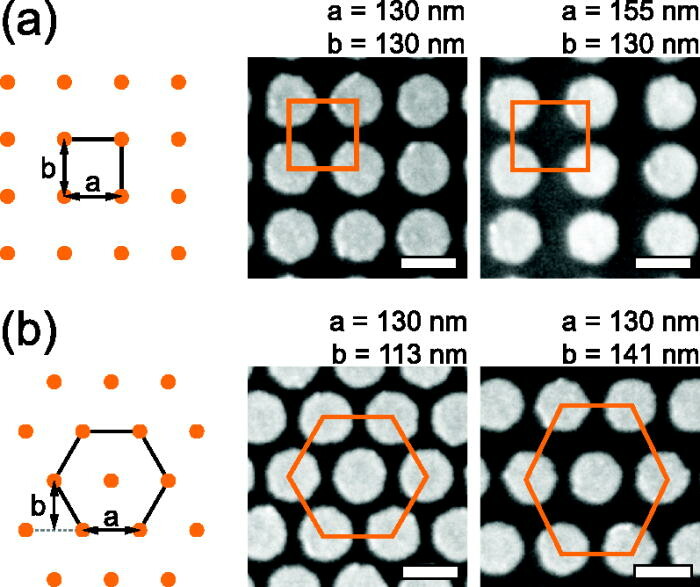 Anisotropy and Domain Formation in a Dipolar Magnetic Metamaterial
Anisotropy and Domain Formation in a Dipolar Magnetic Metamaterial
Einar Digernes, Anders Strømberg, Carlos A. F. Vaz, Armin Kleibert, Jostein K. Grepstad and Erik Folven
Applied Physics. Letters Vol. 118, No. 202404, May 2021
DOI: https://doi.org/10.1063/5.0045450
Open Access: https://hdl.handle.net/11250/2766932
Abstract: Long-range magnetic ordering can be stabilized in arrays of single-domain nanomagnets through dipolar interactions. In these metamaterials, the magnetic properties are determined by geometric parameters such as the nanomagnet shape and lattice symmetry. Here, we demonstrate engineering of the anisotropy in a dipolar magnetic metamaterial by tuning of the lattice parameters. Furthermore, we show how a modified Kittel's law explains the resulting domain configurations of the dipolar ferromagnetic arrays. -
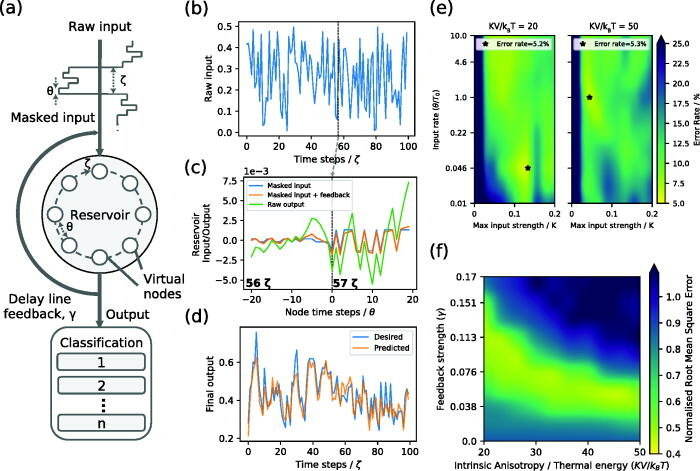 Voltage-controlled superparamagnetic ensembles for low-power reservoir computing
Voltage-controlled superparamagnetic ensembles for low-power reservoir computing
A. Welbourne, A. L. R. Levy, M. O. A. Ellis, H. Chen, M. J. Thompson, E. Vasilaki, D. A. Allwood, T. J. Hayward
Applied Physics Letters Vol. 118, No. 202402, May 2021
Open Access: https://doi.org/10.1063/5.0048911
Abstract: We propose thermally driven, voltage-controlled superparamagnetic ensembles as low-energy platforms for hardware-based reservoir computing. In the proposed devices, thermal noise is used to drive the ensembles' magnetization dynamics, while control of their net magnetization states is provided by strain-mediated voltage inputs. Using an ensemble of CoFeB nanodots as an example, we use analytical models and micromagnetic simulations to demonstrate how such a device can function as a reservoir and perform two benchmark machine learning tasks (spoken digit recognition and chaotic time series prediction) with competitive performance. Our results indicate robust performance on timescales from microseconds to milliseconds, potentially allowing such a reservoir to be tuned to perform a wide range of real-time tasks, from decision making in driverless cars (fast) to speech recognition (slow). The low energy consumption expected for such a device makes it an ideal candidate for use in edge computing applications that require low latency and power. -
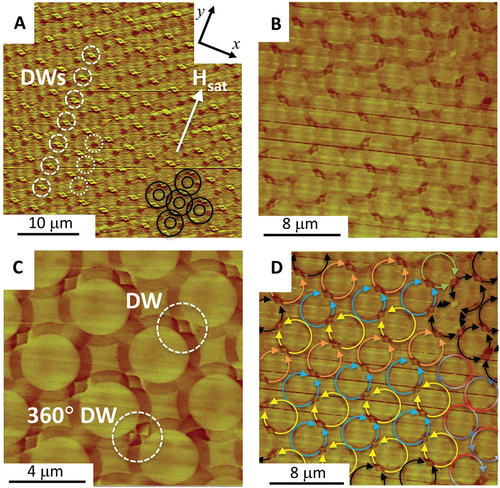 Dynamically Driven Emergence in a Nanomagnetic System
Dynamically Driven Emergence in a Nanomagnetic System
Richard W. Dawidek, Thomas J. Hayward, Ian T. Vidamour, Thomas J. Broomhall, Guru Venkat, Mohanad Al Mamoori, Aidan Mullen, Stephan J. Kyle, Paul W. Fry, Nina-Juliane Steinke, Joshaniel F. K. Cooper, Francesco Maccherozzi, Sarnjeet S. Dhesi, Lucia Aballe, Michael Foerster, Jordi Prat, Eleni Vasilaki, Matthew O. A. Ellis, and Dan A. Allwood
Advanced Functional Materials Vol. 31, No. 15, February 2021
https://doi.org/10.1002/adfm.202008389
Abstract: Emergent behaviors occur when simple interactions between a system's constituent elements produce properties that the individual elements do not exhibit in isolation. This article reports tunable emergent behaviors observed in domain wall (DW) populations of arrays of interconnected magnetic ring-shaped nanowires under an applied rotating magnetic field. DWs interact stochastically at ring junctions to create mechanisms of DW population loss and gain. These combine to give a dynamic, field-dependent equilibrium DW population that is a robust and emergent property of the array, despite highly varied local magnetic configurations. The magnetic ring arrays’ properties (e.g., non-linear behavior, “fading memory” to changes in field, fabrication repeatability, and scalability) suggest they are an interesting candidate system for realizing reservoir computing (RC), a form of neuromorphic computing, in hardware. By way of example, simulations of ring arrays performing RC approaches 100% success in classifying spoken digits for single speakers.
Presentations
-
Recent advances in Artificial Spin Ice
ICAMD, Korean Physical Society (online)
Laura Heyderman
-
Artificial Spin Ice Devices
Panellist for 2nd Online RIEC International Workshop on Spintronics (online)
Laura Heyderman
-
Tutorial: Probing Artificial Spin Ice with Large Scale Facilities
MORIS (Magnetics and Optics Research International Symposium)
Laura Heyderman
-
Tutorial: Three Dimensional Artificial Spin Ice
SPICE Wkshp: Nanomagnetism in 3D, WASEM winery, Ingelheim am Rhein, Germany
Laura Heyderman
-
Recent advances in Artificial Spin Ice
Physics Colloquium, University of Basel
Laura Heyderman
-
Electrically programmable chirally coupled nanomagnets for unconventional computing
ICM 2024 conference-Magnetism community
Zhaouchu, 2024
-
Programmable nanomagnetic Ising network
IUMRS-ICEM 2024 conference Magnetism community
Zhaouchu, 2024
-
Chirally coupled nanomagnetic system
20th RIEC International Workshop on Spintronics-Magnetism community
Zhaouchu, 2023
-
Programmable nanomagnetic Ising network
13th International Conference on Advanced Materials and Devices-Scientific community
Zhaouchu, 2023
-
Nanomagnetic Ising network
International Conference on Frontier Materials 2023-Scientific community
Zhaouchu, 2023
-
MagIC+ Magnetism, Interactions, and Complexity: innovative ideas on spin wave dynamics and transport properties in low-dimensional materials
Invited talk, Poznan, Poland
Ales, 2023
-
Smartphone, Laptop, Supercomputer
Gymnasium level presentation (16-18 year old) at TecDay, Zurich, Switzerland. (TecDay is an initiative of the Swiss Academy of Engineering Sciences (SATW) to promote Science and Technology at pre-University level)
Rolf Allenspach, April 10, 2023
-
Smartphone, Laptop, Supercomputer
Gymnasium level presentation (16-18 year old) at TecDay, Trogen, Switzerland. (TecDay is an initiative of the Swiss Academy of Engineering Sciences (SATW) to promote Science and Technology at pre-University level)
Rolf Allenspach, May 7, 2024
-
Nanomagnetic devices
Seminar, University of Zurich, Switzerland
Rolf Allenspach, May 22, 2024
-
Towards nanomagnetic devices
Seminar, King Abdullah University of Science and Technology, Jeddah (KAUST), Saudi Arabia
Rolf Allenspach, November 6, 2023
-
Rings, films, and antidots: Scaling and power considerations
Workshop, Trondheim, Norway
Rolf Allenspach, June 17, 2024
-
Emergent properties of ferromagnetic ensembles
24 Hours of Science 2023 at IBM Research
Rolf Allenspach, September 19, 2023
-
Computation in magnetic metamaterials
RIEC International Workshop on Spintronics, Online
Johannes H. Jensen, April 6, 2023. -
Towards smart sensing with a spintronic reservoir computer
Magnetism, University of Manchester, Manchester, UK
G. Venkat, I. Vidamour, C. Swindells, T. J. Hayward, D. A. Allwood, April 3-4, 2023.
Presentation slides -
Importance of reservoir architectures in comparing physical reservoir systems
Workshop on Unconventional Computing, Erice, Italy
G. Venkat, I. Vidamour, C. Swindells, T. J. Hayward, D. A. Allwood, October 20-26, 2022.
Presentation slides -
Artificial Spin-Ice
Workshop on Unconventional Computing, Erice, Italy
Gunnar Tufte, October 20-26, 2022. -
Emergent properties of ferromagnetic ensembles
24 Hours of Science 2022 at IBM Research
Rolf Allenspach, September 21, 2022. -
Obtaining additional behaviour from magnetic ring arrays for reservoir computing
Magnetism, University of York, York, UK
G. Venkat, I. Vidamour, C. Swindells, T. J. Hayward, R. Allenspach, A. Bischof, D. A. Allwood, March 28-29, 2022.
Presentation slides -
Towards nanomagnetic devices
Seminar, University Duisburg-Essen, Germany
Rolf Allenspach, January 18, 2022. -
Nanomagnetic devices
Joint IoP/ITN MagnEFi Magnetism School, Leeds, UK
Rolf Allenspach, October 28, 2021. -
Sculpting the Spin Ice for Computation
Third International Workshop on Theoretical and Experimental Material Computing (TEMC), Helsinki, Finland
Arthur Penty, NTNU, October 18-22, 2021. -
Magnetic nanodevices
Young Researchers Workshop on Skyrmions, Annweiler am Trifels, Germarny
Rolf Allenspach, September 13, 2021. -
A Representation of Artificial Spin Ice for Evolutionary Search
ALIFE - Virtual
Arthur Penty, NTNU, July 19-23, 2021. -
Imaging the Emergent Behaviour in Nanoring Assemblies for Reservoir Computing Applications
INTERMAG
Guru Venkat, The University of Sheffield, April 26-30, 2021. -
From Stochasticity to Functionality: Harnessing Magnetic Domain Walls for Probabilistic and Neuromorphic Computing
International Conference on Magnetics (INTERMAG) - Virtual
Tom Hayward, The University of Sheffield, April 26-30, 2021. -
Bio-inspired Artificial Intelligence
NORA/NAIL Webinar
Gunnar Tufte, NTNU, April 23, 2021. -
Introducing Flatspin: Enabling Large Scale Dynamical Artificial Spin Ice SimulationsSculpting the Spin Ice for Computation
The 65th Annual Conference on Magnetism and Magnetic Materials (MMM) - Virtual
Anders Stromberg, NTNU, November 2-6, 2020. -
Domain Wall Dynamics in Junctions of Bi-ring Structures
The 65th Annual Conference on Magnetism and Magnetic Materials (MMM) - Virtual
Guru Venkat, The University of Sheffield, November 2-6, 2020.
Tools
RingSim
RingSim is an agent based phenomenological model which uses magnetic domain walls to simulate the microscopic and macroscopic response of magnetic ring arrays with thousands of elements when stimulated by magnetic fields. The simulator can also be used to test the reservoir computing properties of these arrays by predicting task agnostic reservoir computing metrics and the performance of ring arrays in simulating various tasks.
Partners
Norwegian University of Science and Technology

Erik Folven

Gunnar Tufte

Magnus Själander
The University of Sheffield

Dan Allwood

Tom Hayward
ETH-Zürich

Laura Heyderman
Ghent University

Bartel Van Waeyenberge
